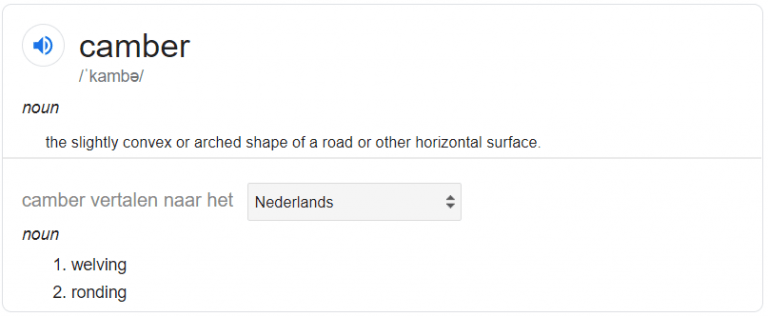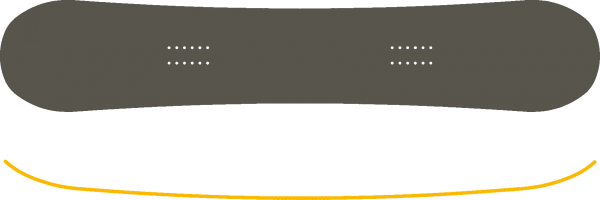At Wax & Board we regularly get the question: “ How do I choose the right Snowboard Camber or profile? “. In this article we would like to give you some more insights about this:
Intro
For both beginners and advanced snowboarders, the search for a new snowboard is not so obvious. Where most of us first look at the prints, and then switch to the stiffness (also called flex) of a board, experts first filter the desired profile. By profile we mean the shape or arc of the board, something that is called in English Camber calls.

First of all, it is very important that we tell you that there is not 1 super good Snowboard Camber profile on the market. Each Camber profile has its advantages and disadvantages, as well as its specific characteristics. The choice of the right profile is often personal, namely because of your style, but also the snow conditions and type of slope you want to ride. For example, you are more likely to look for a stable board for carving, but as soon as you enter the park you want a playful board to learn tricks!
Camber

To make it clear right away; Camber is one of the many profiles that a Snowboard Camber can have. So you really do have the type of Camber: Camber. The Camber profile can be compared to the arch of a typical bridge; low at the beginning and end & high in the middle. If we were to throw all Snowboards together, you can be proud that Camber Snowboards have the largest share of the market. This is mainly due to the amount of pop, stability & how smoothly you can ride on one edge. This makes you stable at cruising speeds, you can quickly pull a line when carving, you pop higher over an object that is on the slope, and you feel a good rebound when cornering.
On the other hand, there are of course also less good points to find; it is less forgiving, which makes it not the best beginner model, and there is also more chance of swallowing snow compared to other profiles. Finally, this type also requires a bit more technique and power to cut corners.
Rocker

A Snowboard with a Rocker profile is literally the opposite of the Camber profile. This Rocker profile is also sometimes called “Reverse Camber”; the tip and tail of this Snowboard stick out in the air and the middle touches the ground. This construction gives a very loose feeling, where you will immediately notice how easy and smooth you can turn with this compared to a “normal” Camber profile. If you´re into jibbing – then you will also quickly notice that piste tricks such as tail or nose presses go a lot smoother because this board spontaneously wants to point into the air! The Rocker Camber not only makes it easy for beginners, but also for Freeriders; a Rocker profile floats smoothly through powder snow due to its construction.
Pros: easy to turn, forgiving (less biting in the snow), requires Tail & Nose presses!
Disadvantages: less stable, less pop, and a little less smooth if you want to keep your edge.
Flat

A Flat Camber profile is, as the name suggests, completely flat. That is why we also call this a Zero Camber, and is literally the bridge between Camber and Rocker profiles. This profile is the ideal compromise, making it versatile. In addition, this is the go to profile to ride park! This type of Snowboard is super stable on boxes and rails because it is completely flat between the bindings.
For some this Camber profile gives a dead feeling by which we mean that there is little life while boarding. Of course the biggest disadvantage is that this Snowboard is neither Camber nor Rocker so the advantages are of course limited.
Custom Camber
In recent years, the evolution in Snowboard Camber has increased enormously. In addition to the 3 traditional Cambers, there are now also Hybrid shapes. It is quite difficult to stick a label on this because each manufacturer uses its own marketing term, but also because there are so many Hybrid shapes possible. With Hybrid we mean that there are 1 or more Camber or Rocker profiles that do not cover the center of your Snowboard.
To keep things simple, we list the 3 “main” shapes here, along with the logic behind them; namely Hybrid Rocker, Hybrid Camber & S-Rocker.
Hybrid Rocker

This type of Snowboard has one Rocker between the bindings and two Camber profiles, namely between binding and Tip / Tail. This Hybrid Rocker profile is widely applicable: you have a fairly loose feeling due to the rocker between your legs. This will also make you surf through powder snow more smoothly compared to, for example, a real Camber profile. On the other hand, the Camber profile under your feet gives more stability and pop, but still significantly less than a real Camber profile.
In general we have to say that this type gives more the feeling of a Rocker than a Camber. That may seem strange because of those 2 Camber zones, but is in itself quite logical because the center of your board is a Rocker.
Disadvantages; Hybrid Rocker is unstable on boxes and rails! You will lose speed.
Pros; Smooth through powder, easier turning, loose feeling, more pop than a standard rocker!
Hybrid Camber

A Hybrid Camber Snowboard profile is the opposite of a Hybrid Rocker. You have 1 Camber zone between your bindings, and 2 rockers under your feet towards the Tip & Tail. The reasoning behind this profile is that you have a much higher range in terms of performance; it must therefore feel stable, hold its edge well and generate a perfect pop. Both Rocker profiles on the nose or tail let you turn faster during turns, it also gives way faster during piste tricks because this profile is already pointing upwards. Whereby this Rocker shape also makes powder snow work smoother. This Hybrid Camber profile feels more like a Camber profile but gives you extra advantages that you can experience with a Rocker.
The advantages of Hybrid Camber are stability, versatile, and good performance to go on its side! Of course, a Hybrid Camber has the disadvantage of that floating feeling that you will only notice with Rockers.
S Rocker

An S-Rocker Snowboard is specifically for Freeride or powder boards. Where these typically have Rocker profiles, a Camber is added here under the feet, between the bindings that are off-center. With powder Snowboards, you stand more to the back so that your nose can go up to plod over the snow. You have already noticed that the extra Camber should provide more stability and will not detract from the floating capacity of those Rocker properties. In addition, this added Camber profile gives more control when you are carving between the trees in the forest, for example. Something quite crucial in our opinion ???? An extra bonus that this S-Rocker Snowboard has can be found in the typical properties of wood; because you place more weight on top of that Camber profile, you push the nose (Rocker profile) more into the air, making it much more efficient. As soon as you step off the Camber profile, you can clearly see the nose sinking back down.
It seems obvious to us that the advantage here is powder snow, but we would like to point out the biggest disadvantage; this is not a snowboard that you want to ride in Switch.
Finally, the advice from Wax & Board
If you are planning to buy a new Snowboard, you should look further than just that cool print, Flex or well-known brand name. Your very first choice is to determine the desired Camber profile. As we have already indicated, the main choices are Camber, Rocker or Flat but increasingly also Hybrid such as Hybrid Camber - Hybrid Rocker or S Rocker.
Which Camber profile is best for you is a very personal choice. We therefore usually advise to test a few different types of Snowboards before making a choice.
If you still can't figure it out, we at Wax & Board would be happy to give you the following personal advice:
- Freestyle & Park: Flat Camber!
- All Mountain: Camber, or Hybrid Camber.
- Freeride: Rocker, or S-Rocker
Are we saying that other Snowboard Camber profiles are not good, or less usable? No absolutely not, we emphasize again that it is a matter of personal taste and choice, but based on the pros and cons you will probably have to go in a certain direction.
